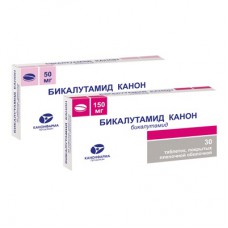Expiration date: 09/2027
Pharmacological action
Pharmacodynamics
Non-steroidal antiandrogenic agent. By contacting the receptors with an affinity for androgens, inhibits the activity of androgens, as a result of this observed regression of prostate tumors. Does not have any other types of endocrine activity.
Pharmacokinetics
After ingestion well absorbed from the gastrointestinal tract. Food intake does not affect bioavailability.
The plasma protein binding is 96%. Extensively metabolized in the liver by oxidation and formation of glucuronide conjugates.
Excreted as metabolites in urine and bile in approximately equal proportions.
Possible accumulation of bicalutamide in the body.
Testimony
Prostate cancer in a combination therapy with a GnRH analogue or surgical castration.
Contraindications
- Concurrent administration with terfenadine, astemizole, cisapride;
- children's age;
- hypersensitivity to bicalutamide;
- do not appoint patients are female.
Application of pregnancy and breastfeeding
Do not appoint patients are female.
Special instructions
To apply caution in patients with moderately severe and severe violations of the liver, because of the possible accumulation of bicalutamide in the body.
During treatment requires regular monitoring of liver function. In case of severe changes, you must stop taking the bicalutamide.
Composition
Active substance: bicalutamide 50 mg.
Excipients: corn starch 35 mg, croscarmellose sodium 6.5 mg, lactose monohydrate 44,3 mg, povidone 3.2 mg, sodium fumarate 1 mg.
The composition of the film shell: Opadry II white 4 mg.
Method of application and doses
Individually, depending on indications and treatment regimens.
Side effects
From the endocrine system: hot flashes, breast tenderness and gynecomastia, decreased libido.
From the digestive system: abdominal pain, diarrhea, nausea, vomiting, increase in transaminases, jaundice, cholestasis.
CNS: asthenia, depression.
Dermatological reactions: alopecia, restore hair growth, itching, dryness of the skin.
Other: hematuria.
Drug interactions
With the use of bicalutamide for 28 days in patients receiving midazolam, AIS of midazolam was increased by 80%.
While the use of bicalutamide with cyclosporine or calcium channel blockers may potentiate or development of adverse reactions.
It is theoretically possible to increase the concentration of bicalutamide in plasma in its simultaneous application with inhibitors of microsomal liver enzymes, which may be accompanied by an increase in the incidence of adverse reactions.
In vitro studies have shown that bicalutamide can displace the anticoagulant cumarin number of warfarin from binding sites to plasma proteins.
Overdose
Cases of overdose in humans have not been described. There is no specific antidote. Treatment is symptomatic. Dialysis is not effective as bicalutamide binds strongly to proteins and is not excreted by the kidneys in unchanged form. Shows a General supportive treatment and monitoring of vital body functions.


